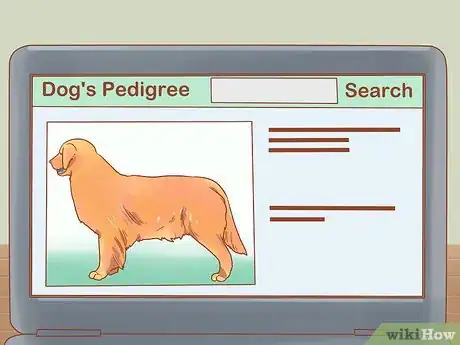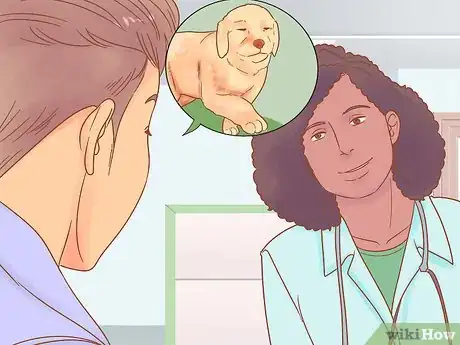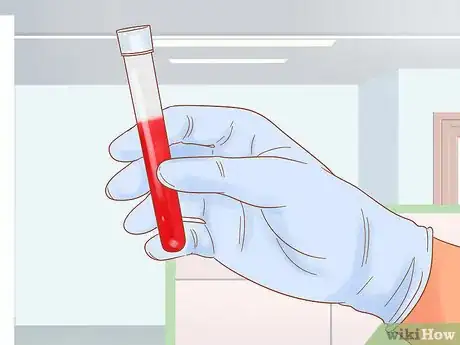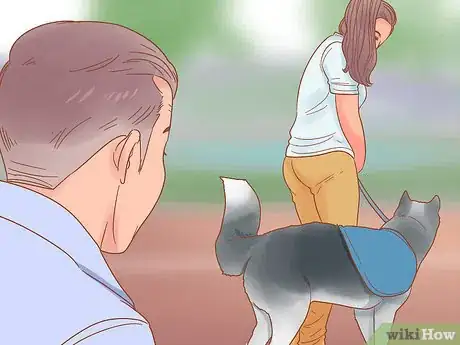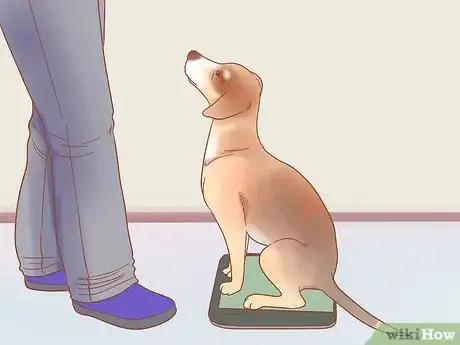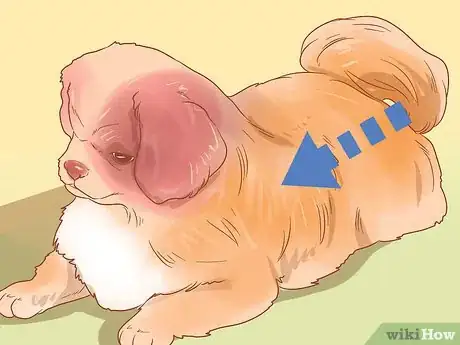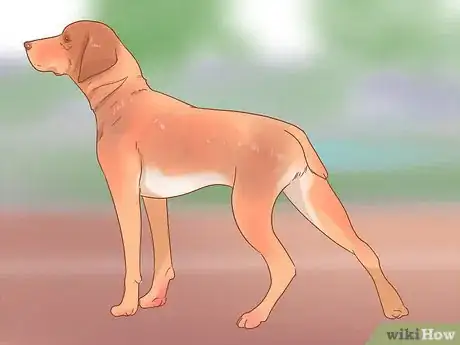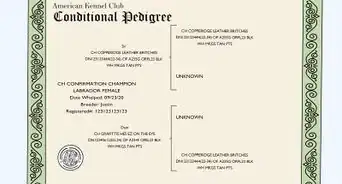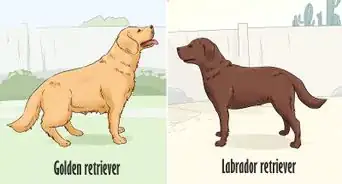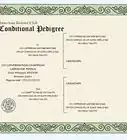This article was co-authored by Pippa Elliott, MRCVS. Dr. Elliott, BVMS, MRCVS is a veterinarian with over 30 years of experience in veterinary surgery and companion animal practice. She graduated from the University of Glasgow in 1987 with a degree in veterinary medicine and surgery. She has worked at the same animal clinic in her hometown for over 20 years.
There are 8 references cited in this article, which can be found at the bottom of the page.
This article has been viewed 488,253 times.
There are many reasons you might want to know your dog's breed, from curiosity to insights into characteristics or learning about any health problems they may encounter in the future as a result of breed predispositions. You may find your rescue dog is purebred, or that your mutt or hybrid pup is a mix of many different breeds. Whether you use science or simply make a well-educated guess, you will be able to better answer that common question: "Oh! What kind of dog is that?"
Steps
Relying on Expertise and Science
-
1Decide how much you want to know. If you are just casually curious about your pup's breed makeup, you might be able to figure it out based on their appearance. If you want to know if your dog is predisposed to any health issues based on their breed, however, then you may need to go to the experts.[1] If so, relying on documentary evidence, expert assistance, and/or scientific analysis will prove more helpful.
- For instance, if you find out your dog is part Doberman Pinscher, you will know that they are predisposed to heart disease and certain neck and spine issues. You can then inform your vet so they know to watch for any signs and symptoms as well as educating yourself on these health issues.
-
2Check your purebred dog's pedigree. Most purebred owners are well aware of their prized pup's pedigree, but sometimes records are lost or forgotten. If your dog is a purebred but that's all you know, you may still be able to find out more information.
- If you are confident your dog is not purebred, skip to the next step.
- If you acquired your purebred according to the regulations of the kennel club to which it belongs, you should be able to retrieve pedigree information either online or in hard copy by contacting the club with your dog's registration number.
- If you don't have this information, you may still be able to figure out which kennel club is likely to have the relevant records, and you may still be able to retrieve pedigree information through an online search of their records.
Advertisement -
3Ask your veterinarian about breed possibilities. Your vet sees dogs all day, has a lot of experience with a wide variety of breeds, and can probably provide some valuable insights about your dog's background.
- Ask his or her opinion about what breed your dog might be. They may have a very good idea or they may give you some suggestions that you will have to further investigate.
- You could also ask a groomer or breeder and see what ideas they have about your dog’s breed. They see dogs all day as well, after all.
-
4Consider DNA testing. A quick online search will reveal that several companies now offer DNA testing kits for dogs, which can determine which breeds are present in your canine. Remember that not all home tests are created equal — the accuracy of the results depends on the size of their reference database. A less expensive test may save you money, but will likely have a smaller database, which will provide less accurate information.
- For instance, a test might be able to tell you that your mutt is 60% lab with 30% dachshund and 10% of "other" in the mix.
-
5Order the DNA test. If you decide to go this route, there are several options that vary by precision, complexity, and price (all of which tend to increase together).
- Tests ranging from $60 and up are available both online and in many pet supply stores. Most of the kits require a cheek swab sampling. Some more expensive ones may require a blood test from a veterinarian's office.
- To swab your dog's cheek, first check to make sure there is no food or debris stuck between their cheek and gums. Open the swab that comes with the kit (avoid touching the bristles) and lift your dog's lip. Place the swab against the inner surface of your dog's lip, then lower the lip. Twirl the swab and move it back and forth a little, gently holding your dog's mouth shut. Allow the swab to dry for about five minutes, then place it in the container provided.
- The results come in two to four weeks either by mail or email.[2]
- Regardless of the limitations and costs associated with DNA testing, this is the most scientific, and likely most accurate, way to determine your mutt's breed profile.
Predicting Based on Physical Characteristics
-
1Accept the limitations of visual identification. While it is nice to think that an expert in particular should be able to identify a dog's breed makeup just by looking over the animal, this method is not the most accurate.
- One study on visual dog breed identification found that even self-described "dog experts" were only able to correctly identify a predominant breed in a mixed-breed dog about 27% of the time.[3]
- Regardless of accuracy concerns, however, identification by visual appearance is the most likely method for use by the average mutt owner, and often sufficient to satisfy a general curiosity. Best of all, it's free.
-
2Write down your dog's defining characteristics as you identify them. Make a list that ranks your dog's distinguishing features from most to least prominent (such as large, pointy ears versus average build). This will help you narrow your search for likely breed(s).
-
3Determine the dog's weight and height. If you don't have a pet scale, weigh yourself and then weigh yourself holding your dog. The difference between the two weights is the weight of your dog. Of course, you can also get your pet’s weight at any veterinary office.
- Take measuring tape and measure your dog from front to back, top to bottom, and left to right.
- These general measurements will allow you to rule out breeds that are drastically different from your dog. For instance, if your dog weighs 50 pounds, you will know that you don't have a small toy breed.
- Toy dogs (5–10 pounds (2.3–4.5 kg)) may include Chihuahuas and Shih Tzu, for instance; dogs in the middle range (10–50 pounds (4.5–22.7 kg)), may perhaps be terriers or spaniels; large dogs (50–100 pounds (23–45 kg)) could be setters or retrievers; and dogs over 100 pounds (45 kg) likely have some element of Saint Bernard, Mastiff, or other giants in their breed mix.[4]
- If your dog is a puppy, seek out an online calculator that will let you use puppy age and weight to estimate adult weight.
-
4Assess the build of your dog. Make note of any defining characteristics you notice. Do you have a large, medium or small-framed dog? Deep chested? Is your dog more muscular or slender in build?
- If you have a puppy, you may have to wait until it is fully mature for all characteristics to become apparent.
- Think about what the build of your dog might mean about its skills. This may help you narrow down the breed group. For instance, if your dog has long legs and is slender, your dog may be a herding dog.
-
5Look at other physical characteristics. Look at your dog's snout, skull, back, legs, and tail, and note any distinctive elements.
- Dogs like Pugs and Bulldogs have round skulls and very short snouts (brachycephalic), whereas Collies and Greyhounds have long snouts and narrow skulls (dolichocephalic). Mesocephalic dogs have skulls that most of us think are balanced (not exaggerated), like that of a Labrador or an Australian Shepherd.
- Visit How to Identify Your Adopted Mutt for several examples of physical characteristics that can often be tied to certain breeds or breed groups.
-
6Evaluate the fur. Is the fur long or short or heavy with undercoat? Is the texture coarse or soft? Some breeds, like Dachshunds, have long backs and short legs and three different types of fur-coat: long, short and wiry. Other breeds only have one type of fur, like the short semi-spiky velvet of the Chinese Shar-Pei breed or the white fluffy fur of the American Eskimo breed.
- There are a wide variety of types of dog fur. Rottweilers tend to only have short black and mahogany fur with specific markings on the head and chest. Many (not all) terriers have wiry coats with short, stocky bodies like that of the Cairn Terrier, the Miniature Schnauzer and the Jack Russell (aka Parsons) terrier. Poodles have the distinction of having curly coats of springy curls in a variety of sizes and colors.[5]
-
7Assess the color of your dog. What color is the fur? Is there a pattern to the coat color? Some breeds typically come in only one or a few colors or patterns, which may help narrow the possibilities.
- For example, German Shorthair Pointer dogs usually come in liver and white and Vizslas are a solid copper color. There are breeds that also come in a merle pattern where diluted black or red colors are mixed in with white like the blue merle Australian Shepherd or Shetland Sheepdog.
-
8Use the visual clues you have recorded to search for breeds and make your "best guess." No matter how detailed your description is, you'll never be able to make a completely accurate determination of your dog's breed. However, with the help of one or more dog breed description guides, you can at very least eliminate many possibilities.
- There are numerous online options for dog breed searches, which use photos and brief character trait descriptions to help you find matches for your mutt.[6] Some also break down the categories by dog size, from "toy" to XL.[7]
- The American Kennel Club (AKC) breed search, for example, provides images and brief descriptions of characteristics common to each breed.[8]
- Eliminate breed groups that don't fit your dog's characteristics. After that, go through pictures and descriptions of breed groups that are similar to your dog.
- Remember that your dog is quite possibly a mix of several different breeds. If your dog has some striking characteristics that match a breed, but it doesn't match completely, it may only partially be that breed.
Expert Q&A
Did you know you can get expert answers for this article?
Unlock expert answers by supporting wikiHow
-
QuestionWhat is the Doge dog?
 Pippa Elliott, MRCVSDr. Elliott, BVMS, MRCVS is a veterinarian with over 30 years of experience in veterinary surgery and companion animal practice. She graduated from the University of Glasgow in 1987 with a degree in veterinary medicine and surgery. She has worked at the same animal clinic in her hometown for over 20 years.
Pippa Elliott, MRCVSDr. Elliott, BVMS, MRCVS is a veterinarian with over 30 years of experience in veterinary surgery and companion animal practice. She graduated from the University of Glasgow in 1987 with a degree in veterinary medicine and surgery. She has worked at the same animal clinic in her hometown for over 20 years.
Veterinarian
-
QuestionHow do you tell the age of a dog?
 Pippa Elliott, MRCVSDr. Elliott, BVMS, MRCVS is a veterinarian with over 30 years of experience in veterinary surgery and companion animal practice. She graduated from the University of Glasgow in 1987 with a degree in veterinary medicine and surgery. She has worked at the same animal clinic in her hometown for over 20 years.
Pippa Elliott, MRCVSDr. Elliott, BVMS, MRCVS is a veterinarian with over 30 years of experience in veterinary surgery and companion animal practice. She graduated from the University of Glasgow in 1987 with a degree in veterinary medicine and surgery. She has worked at the same animal clinic in her hometown for over 20 years.
Veterinarian This is difficult to do in adult dogs. Factors such as the dog's diet and whether they chew stones or sticks can influence signs of wear on the teeth. Also, unlike horses, dog's don't have characteristic marks that appear on the teeth with age. Vets use their experience to gauge the dog's teeth, body condition, and demeanor in order to give an approximate age.
This is difficult to do in adult dogs. Factors such as the dog's diet and whether they chew stones or sticks can influence signs of wear on the teeth. Also, unlike horses, dog's don't have characteristic marks that appear on the teeth with age. Vets use their experience to gauge the dog's teeth, body condition, and demeanor in order to give an approximate age. -
QuestionHow do dog DNA tests work?
 Pippa Elliott, MRCVSDr. Elliott, BVMS, MRCVS is a veterinarian with over 30 years of experience in veterinary surgery and companion animal practice. She graduated from the University of Glasgow in 1987 with a degree in veterinary medicine and surgery. She has worked at the same animal clinic in her hometown for over 20 years.
Pippa Elliott, MRCVSDr. Elliott, BVMS, MRCVS is a veterinarian with over 30 years of experience in veterinary surgery and companion animal practice. She graduated from the University of Glasgow in 1987 with a degree in veterinary medicine and surgery. She has worked at the same animal clinic in her hometown for over 20 years.
Veterinarian The home DNA test kits you buy over the internet work by harvesting a sample of DNA from the lining of the dog's cheek. The swab is sent away in a special transport medium. The company then analyzes the DNA sequence and compares it to a computer register of DNA from known dog breeds. Where the DNA is the same, this identifies the parent breed.
The home DNA test kits you buy over the internet work by harvesting a sample of DNA from the lining of the dog's cheek. The swab is sent away in a special transport medium. The company then analyzes the DNA sequence and compares it to a computer register of DNA from known dog breeds. Where the DNA is the same, this identifies the parent breed.
References
- ↑ http://pets.webmd.com/dogs/features/dog-dna-testing?page=2
- ↑ http://pets.webmd.com/dogs/features/dog-dna-testing
- ↑ https://vetmed-maddie.sites.medinfo.ufl.edu/files/2012/05/2012-Croy-Maddies-Shelter-Medicine-Confernce-Abstract.pdf
- ↑ http://www.merckvetmanual.com/pethealth/dog_basics/description_and_physical_characteristics_of_dogs/description_and_physical_characteristics_of_dogs.html
- ↑ http://www.akc.org/dog-breeds/
- ↑ https://www.petfinder.com/dog-breeds/
- ↑ http://www.dogbreedinfo.com/photosearch.htm
- ↑ http://www.akc.org/dog-breeds/
- ↑ http://www.akc.org/dog-owners/canine-partners/
About This Article
To determine your dog’s breed, write down your dog’s defining characteristics, such as its weight, height, and build. You should also make observations about the length and type of your dog's fur, the color of its hair and eyes, and the shape of its ears. Then, after you write down your dog's characteristics, use them to search for breeds on The American Kennel Club website. Keep in mind that this method won't be as reliable as a DNA test or taking your dog to a vet. For more tips from our Veterinary reviewer, including how to perform an at-home DNA test on your dog, keep reading!

